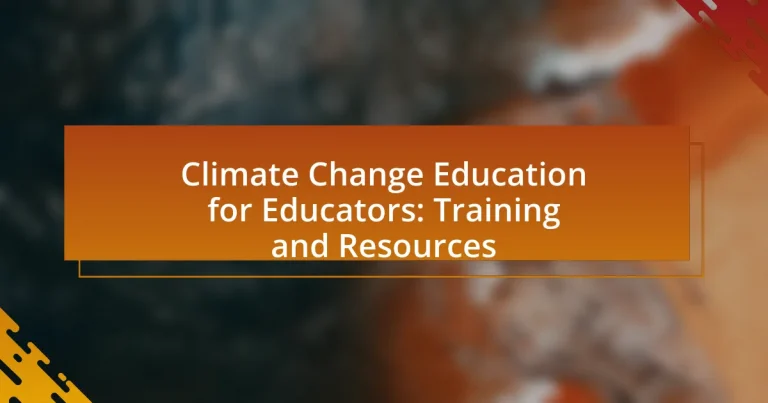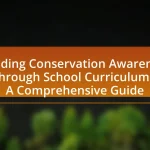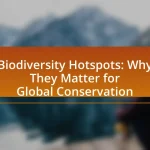Climate Change Education for Educators is a structured framework aimed at equipping teachers with essential knowledge and skills to effectively teach climate change concepts. The article outlines the importance of this education in fostering critical thinking and problem-solving skills among students, while also addressing the key concepts educators must understand, such as the greenhouse effect and human impact on climate. It discusses various training resources and programs available for educators, including online courses and workshops, and highlights best practices for integrating climate change into curricula across different subjects. Additionally, the article examines the challenges educators face in teaching climate change and offers practical tips for overcoming resistance and enhancing student engagement.
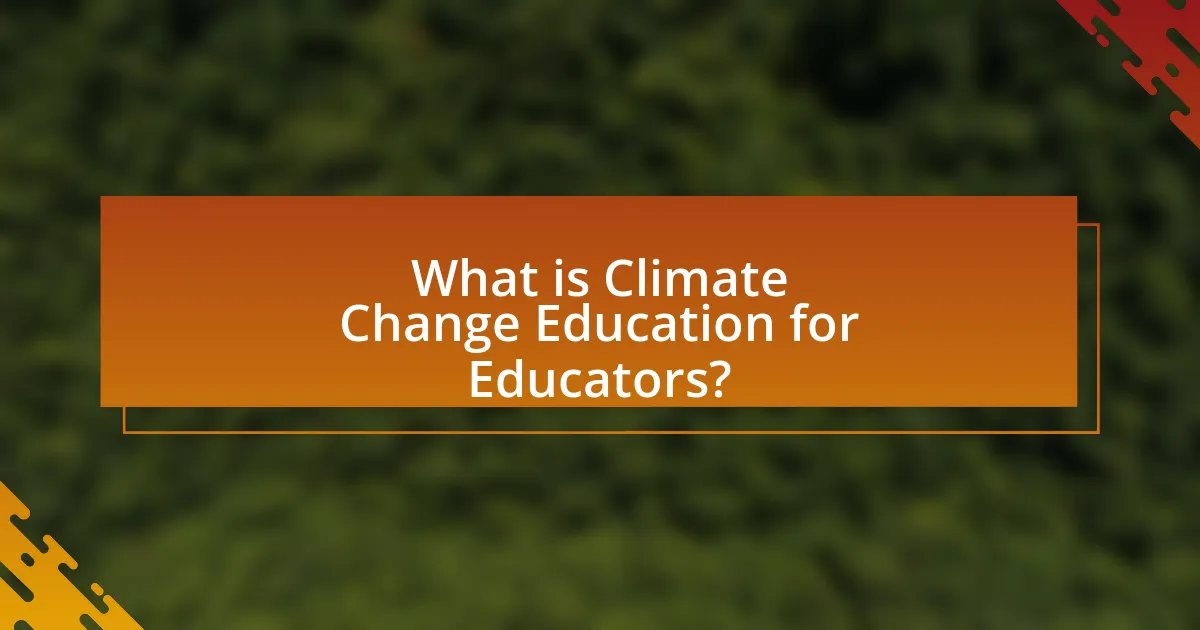
What is Climate Change Education for Educators?
Climate Change Education for Educators is a structured approach designed to equip teachers with the knowledge and skills necessary to effectively teach students about climate change. This educational framework emphasizes the importance of understanding climate science, its impacts, and the role of human activity in climate change. Research indicates that effective climate change education can enhance students’ critical thinking and problem-solving skills, enabling them to engage with environmental issues more meaningfully. For instance, the National Oceanic and Atmospheric Administration (NOAA) provides resources and training programs that help educators integrate climate science into their curricula, demonstrating the practical application of climate change education in classrooms.
Why is Climate Change Education important for educators?
Climate Change Education is important for educators because it equips them with the knowledge and skills necessary to teach students about the complexities of climate change and its impacts. Educators play a crucial role in shaping the understanding and attitudes of future generations towards environmental issues. Research indicates that effective climate change education can lead to increased awareness and proactive behaviors among students, fostering a generation that is better prepared to address climate challenges. For instance, a study published in the journal “Environmental Education Research” highlights that students exposed to comprehensive climate education demonstrate a greater understanding of climate science and are more likely to engage in sustainable practices.
What are the key concepts of climate change that educators need to understand?
The key concepts of climate change that educators need to understand include the greenhouse effect, climate systems, human impact, and adaptation and mitigation strategies. The greenhouse effect describes how gases like carbon dioxide trap heat in the atmosphere, leading to global warming. Climate systems encompass the interactions between the atmosphere, oceans, and land, which influence weather patterns and climate variability. Human impact refers to activities such as fossil fuel combustion and deforestation that significantly contribute to climate change. Adaptation strategies involve adjusting practices to minimize damage from climate impacts, while mitigation strategies focus on reducing greenhouse gas emissions to limit future warming. Understanding these concepts is essential for educators to effectively teach students about the complexities of climate change and its implications for society and the environment.
How does climate change impact various educational subjects?
Climate change significantly impacts various educational subjects by altering curricula to include environmental science, social studies, and health education. For instance, in environmental science, students learn about climate systems, greenhouse gases, and ecological impacts, which are essential for understanding climate change. In social studies, the focus shifts to the socio-economic effects of climate change, such as migration patterns and resource distribution, highlighting the interconnectedness of global issues. Health education incorporates discussions on climate-related health risks, including heat-related illnesses and the spread of infectious diseases, emphasizing the importance of public health in the context of climate change. These adaptations in educational subjects are supported by research indicating that integrating climate change into education enhances students’ critical thinking and problem-solving skills, preparing them for future challenges.
What are the goals of Climate Change Education for Educators?
The goals of Climate Change Education for Educators include equipping teachers with the knowledge and skills necessary to effectively teach climate change concepts, fostering critical thinking and problem-solving skills among students, and promoting awareness of the social, economic, and environmental impacts of climate change. These goals aim to create a generation of informed citizens who can engage in climate action and advocate for sustainable practices. Research indicates that effective climate change education can lead to increased student engagement and a deeper understanding of the complexities surrounding climate issues, ultimately contributing to a more sustainable future.
How can educators effectively communicate climate change issues to students?
Educators can effectively communicate climate change issues to students by using interactive teaching methods that engage students in critical thinking and problem-solving. Research indicates that hands-on activities, such as experiments and simulations, enhance understanding and retention of complex topics like climate change. For instance, a study published in the journal “Environmental Education Research” found that students who participated in project-based learning about climate change demonstrated a significant increase in knowledge and a greater likelihood of adopting pro-environmental behaviors. Additionally, incorporating local climate data and case studies makes the issue more relatable, fostering a personal connection to the material.
What skills should educators develop to teach climate change effectively?
Educators should develop skills in scientific literacy, critical thinking, and effective communication to teach climate change effectively. Scientific literacy enables educators to understand and convey complex climate science concepts accurately, while critical thinking skills allow them to analyze and evaluate climate-related information critically. Effective communication skills are essential for engaging students and fostering discussions about climate change impacts and solutions. Research indicates that educators who possess these skills can significantly enhance students’ understanding and motivation to address climate issues, as highlighted in the National Research Council’s report on climate literacy, which emphasizes the importance of these competencies in education.
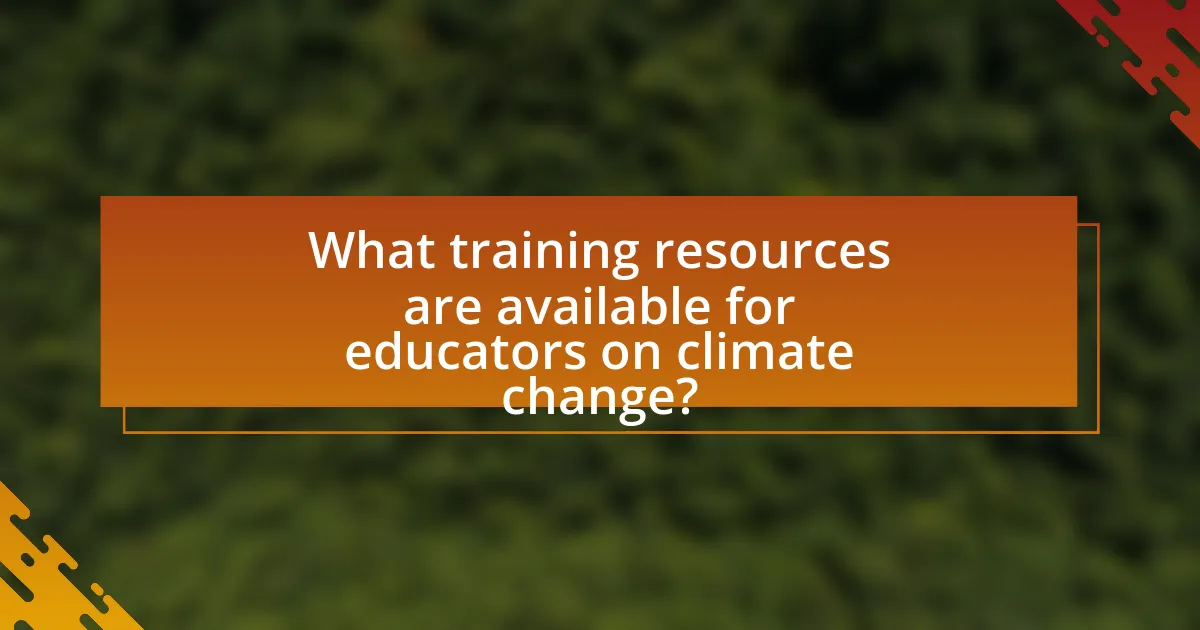
What training resources are available for educators on climate change?
Training resources available for educators on climate change include online courses, workshops, and teaching materials provided by organizations such as the National Oceanic and Atmospheric Administration (NOAA) and the National Science Teachers Association (NSTA). NOAA offers the “Climate Literacy and Energy Awareness Network” (CLEAN), which provides a collection of educational resources and activities focused on climate science. The NSTA offers professional development opportunities, including webinars and conferences, specifically addressing climate change education. Additionally, the “Climate Change Education” initiative by the U.S. Department of Education provides guidelines and resources to integrate climate change into K-12 curricula. These resources are designed to enhance educators’ understanding of climate issues and improve their teaching strategies.
What types of training programs exist for educators?
Various types of training programs exist for educators, including professional development workshops, online courses, certification programs, and collaborative learning communities. Professional development workshops often focus on specific teaching strategies or subject matter, while online courses provide flexible learning options on topics such as climate change education. Certification programs can enhance educators’ credentials and expertise in environmental education. Collaborative learning communities foster peer-to-peer learning and resource sharing among educators. These training programs are essential for equipping educators with the knowledge and skills necessary to effectively teach climate change and related topics.
How do online courses compare to in-person workshops for climate change education?
Online courses offer flexibility and accessibility, while in-person workshops provide hands-on experiences and direct interaction. Online courses can reach a broader audience, allowing participants from various locations to engage without travel, which is particularly beneficial for climate change education that requires widespread participation. In contrast, in-person workshops facilitate networking and immediate feedback, enhancing collaborative learning and engagement. Research indicates that experiential learning, often found in workshops, can lead to better retention of information, as shown in studies by the National Oceanic and Atmospheric Administration, which emphasize the importance of interactive learning in environmental education.
What are some reputable organizations offering climate change training for educators?
Reputable organizations offering climate change training for educators include the National Oceanic and Atmospheric Administration (NOAA), which provides resources and professional development focused on climate science and education. The Climate Reality Project also offers training programs aimed at equipping educators with the tools to teach climate change effectively. Additionally, the National Science Teachers Association (NSTA) provides resources and workshops specifically designed for educators to integrate climate change into their curricula. These organizations are recognized for their commitment to enhancing climate literacy among educators and their students.
What materials and resources can educators utilize in their teaching?
Educators can utilize a variety of materials and resources in their teaching, including textbooks, online courses, multimedia presentations, and interactive simulations. For instance, textbooks provide foundational knowledge, while online courses from platforms like Coursera or edX offer structured learning experiences. Multimedia presentations, such as videos and infographics, can enhance engagement and understanding, and interactive simulations allow students to explore complex concepts in a hands-on manner. Research indicates that diverse teaching materials can improve student comprehension and retention, making them essential tools in effective education.
What types of teaching materials are most effective for climate change education?
Interactive teaching materials, such as simulations, hands-on activities, and digital tools, are most effective for climate change education. These materials engage students actively, allowing them to explore complex concepts through experiential learning. Research indicates that interactive methods enhance understanding and retention of climate science; for instance, a study published in the Journal of Environmental Education found that students using simulations demonstrated a 30% increase in knowledge retention compared to traditional lecture-based approaches. Additionally, visual aids like infographics and videos can simplify complex data, making it more accessible and relatable for learners.
How can educators access free resources for climate change teaching?
Educators can access free resources for climate change teaching through various online platforms and organizations dedicated to environmental education. Websites such as NASA’s Climate Change Education resources, the National Oceanic and Atmospheric Administration (NOAA), and the United Nations Educational, Scientific and Cultural Organization (UNESCO) provide comprehensive materials, lesson plans, and interactive tools specifically designed for educators. These resources are often backed by scientific research and are updated regularly to reflect the latest findings in climate science, ensuring that educators have access to accurate and relevant information for their teaching.

How can educators implement climate change education in their classrooms?
Educators can implement climate change education in their classrooms by integrating interdisciplinary approaches that connect climate science with subjects like geography, biology, and social studies. This can be achieved through project-based learning, where students engage in real-world problems related to climate change, such as local environmental issues or sustainability practices. Research indicates that hands-on activities and discussions about climate impacts enhance student engagement and understanding, as shown in studies by the National Oceanic and Atmospheric Administration, which emphasize the effectiveness of experiential learning in environmental education. Additionally, utilizing resources from organizations like the Climate Reality Project can provide educators with lesson plans and materials tailored to various grade levels, ensuring that the content is age-appropriate and relevant.
What strategies can educators use to integrate climate change into their curriculum?
Educators can integrate climate change into their curriculum by employing interdisciplinary approaches that connect climate science with subjects like geography, biology, and social studies. This strategy allows students to understand the multifaceted impacts of climate change, such as its effects on ecosystems, weather patterns, and human societies. For instance, incorporating real-world data and case studies, such as the rise in global temperatures documented by NASA, can enhance students’ engagement and comprehension. Additionally, project-based learning, where students participate in local environmental initiatives, fosters practical understanding and responsibility towards climate issues. Research indicates that hands-on experiences significantly improve students’ retention of climate-related concepts, making these strategies effective for comprehensive climate change education.
How can project-based learning enhance climate change education?
Project-based learning enhances climate change education by actively engaging students in real-world problems, fostering critical thinking and collaboration. This approach allows learners to investigate climate issues through hands-on projects, which can lead to a deeper understanding of environmental science and sustainability practices. Research indicates that students involved in project-based learning demonstrate improved retention of knowledge and greater motivation, as they see the relevance of their studies to pressing global challenges. For instance, a study by Thomas Markham in “Project Based Learning Handbook” highlights that students who participate in project-based learning are more likely to develop skills necessary for addressing complex issues like climate change, thus preparing them for future challenges.
What role does interdisciplinary teaching play in climate change education?
Interdisciplinary teaching plays a crucial role in climate change education by integrating knowledge and methods from various disciplines to provide a comprehensive understanding of climate issues. This approach enables students to see the interconnectedness of environmental science, economics, social studies, and ethics, fostering critical thinking and problem-solving skills essential for addressing climate challenges. Research indicates that interdisciplinary curricula enhance student engagement and retention of information, as evidenced by studies showing improved academic performance in programs that incorporate multiple perspectives on climate change.
What challenges do educators face in teaching climate change?
Educators face several challenges in teaching climate change, primarily due to the complexity of the subject and varying levels of student understanding. The scientific intricacies of climate change, including its causes, effects, and potential solutions, can overwhelm both educators and students. Additionally, educators often encounter resistance from students or parents who may hold differing beliefs about climate change, complicating discussions. A study by the National Center for Science Education found that only 27% of teachers felt adequately prepared to teach climate change, highlighting a significant gap in training and resources. Furthermore, the lack of standardized curriculum and resources across different educational systems can hinder effective teaching.
How can educators overcome resistance to climate change topics in the classroom?
Educators can overcome resistance to climate change topics in the classroom by integrating interdisciplinary approaches that connect climate change to students’ personal experiences and local contexts. This method fosters relevance and engagement, making the topic more relatable. Research indicates that when educators utilize project-based learning and real-world problem-solving, students are more likely to embrace complex subjects like climate change. For instance, a study published in the Journal of Environmental Education Research found that students who participated in hands-on environmental projects showed a 30% increase in their understanding and acceptance of climate change concepts. By creating a supportive environment that encourages open dialogue and critical thinking, educators can effectively address misconceptions and resistance.
What support systems are available for educators facing challenges in climate change education?
Support systems available for educators facing challenges in climate change education include professional development programs, online resources, and community networks. Professional development programs, such as those offered by organizations like the National Science Teachers Association, provide educators with training on climate science and effective teaching strategies. Online resources, including platforms like Climate.gov and the National Oceanic and Atmospheric Administration, offer lesson plans, data sets, and multimedia tools to enhance classroom instruction. Additionally, community networks, such as local environmental organizations and teacher collaboratives, facilitate peer support and resource sharing among educators. These systems collectively empower educators to effectively teach climate change concepts and engage students in meaningful discussions about environmental issues.
What are best practices for teaching climate change effectively?
Best practices for teaching climate change effectively include integrating interdisciplinary approaches, utilizing local and global case studies, and fostering critical thinking skills. Interdisciplinary approaches allow educators to connect climate change to various subjects such as science, economics, and social studies, enhancing student engagement and understanding. Utilizing local and global case studies provides real-world context, making the issue more relatable and urgent for students. Fostering critical thinking skills encourages students to analyze data, evaluate sources, and develop their own informed opinions on climate change. Research from the National Oceanic and Atmospheric Administration (NOAA) emphasizes that these strategies lead to improved student comprehension and retention of climate-related concepts.
How can educators assess student understanding of climate change concepts?
Educators can assess student understanding of climate change concepts through a combination of formative assessments, summative assessments, and project-based learning. Formative assessments, such as quizzes and classroom discussions, allow educators to gauge students’ grasp of key concepts in real-time. Summative assessments, including tests and final projects, provide a comprehensive evaluation of students’ knowledge at the end of a unit. Project-based learning, where students engage in hands-on activities related to climate change, fosters deeper understanding and application of concepts. Research indicates that active learning strategies, such as those used in project-based assessments, significantly enhance student engagement and retention of climate change knowledge.
What are some successful case studies of climate change education in action?
Successful case studies of climate change education include the “Climate Change Education Partnership” (CCEP) initiative, which engaged over 1,000 educators across the United States to integrate climate science into their curricula. This program demonstrated significant improvements in students’ understanding of climate change concepts, with assessments showing a 30% increase in knowledge retention. Another example is the “Eco-Schools” program, which operates in over 60 countries and encourages schools to implement sustainability practices. Schools participating in this program reported a 50% reduction in waste and increased student engagement in environmental stewardship activities. These case studies highlight effective strategies in climate change education that lead to measurable outcomes in both knowledge and behavior.
What practical tips can educators follow for effective climate change education?
Educators can enhance climate change education by integrating interdisciplinary approaches, utilizing local environmental issues, and fostering critical thinking. Interdisciplinary approaches allow educators to connect climate change with subjects like science, geography, and social studies, making the topic more relatable and comprehensive. For instance, a study by the National Oceanic and Atmospheric Administration (NOAA) emphasizes that integrating climate science into various subjects increases student engagement and understanding.
Utilizing local environmental issues helps students see the direct impact of climate change in their communities, making the subject matter more relevant. For example, discussing local weather patterns or conservation efforts can ground abstract concepts in real-world experiences.
Fostering critical thinking encourages students to analyze data, debate solutions, and engage in problem-solving activities related to climate change. Research from the National Science Teaching Association indicates that inquiry-based learning strategies significantly improve students’ ability to understand and address complex environmental issues.
By implementing these practical tips, educators can create a more effective and impactful climate change education experience.
